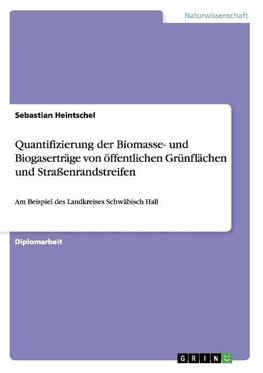
-
 Nemecký jazyk
Nemecký jazyk
Quantifizierung der Biomasse- und Biogaserträge von öffentlichen Grünflächen und Straßenrandstreifen
Autor: Sebastian Heintschel
Diplomarbeit aus dem Jahr 2012 im Fachbereich Biologie - Ökologie, Note: 1,8, Technische Universität Bergakademie Freiberg, Sprache: Deutsch, Abstract: Biomass production for energy purposes on agricultural land competes with food production. This is a serious... Viac o knihe
Na objednávku
44.37 €
bežná cena: 49.30 €
O knihe
Diplomarbeit aus dem Jahr 2012 im Fachbereich Biologie - Ökologie, Note: 1,8, Technische Universität Bergakademie Freiberg, Sprache: Deutsch, Abstract: Biomass production for energy purposes on agricultural land competes with food production. This is a serious problem, considering limited availability of farmland, rising demand for varied food products, demand for more organic crop production resulting in considerably reduced yields per area and the need for more environmentally sound agricultural practices meeting long-term sustainability criteria. Residual land currently not used for agricultural production has been considered a promising resource, but in terms of potentials difficult to estimate for biomass for use in the energy sector. Biomass potentials associated with "green waste" from residual grasslands were assessed for Schwäbisch Hall County in the Federal State of Baden-Württemberg, Germany. Roadside verges, conservation grasslands subject to low intensity use (landscape maintenance sites), riparian stretches along ditches and streams, and municipal green spaces (public lawns, parks and sports fields) were the area types considered. Data for biomass and biogas yields were obtained through sampling and the help of the Hohenheimer Biogasertragstests (HBT) and near infrared spectroscopy (NIRS). These values were compared with available values from literature and based on the DLG-Futterwerttabelle (UNIVERSITÄT HOHENHEIM 1997) calculated with the help of the model of KEYMER & SCHILCHER (1999). It was found that mean biomass yields exceeded literature values by 34% for riparian stretches, 14% for sports fields and 23% for roadside verges. For municipal grasslands mean biomass yields were 233% below literature values. Taken into account the calculation model of KEYMER & SCHILCHER (1999), biogas yields for sports fields and municipal grasslands were 21% and 9% respectively, below the obtained values. For a composite sample and riparian stretches, calculated values were 4 and 12% higher than the obtained values. Based on the obtained values the maximum available biomass and biogas yields were estimated for the communities. This implies a yearly biomass potential of all land types in the district of Schwäbisch Hall of 12.692 t and a biogas potential of approximately 8,3 Mio. m³/oTS. The results suggest that a very high percentage of the theoretical residual biomass potential cannot be accessed due to various technical, legal, ecological or management (economic) constraints.
- Vydavateľstvo: GRIN Verlag
- Rok vydania: 2013
- Formát: Paperback
- Rozmer: 210 x 148 mm
- Jazyk: Nemecký jazyk
- ISBN: 9783656553847

 Anglický jazyk
Anglický jazyk 










